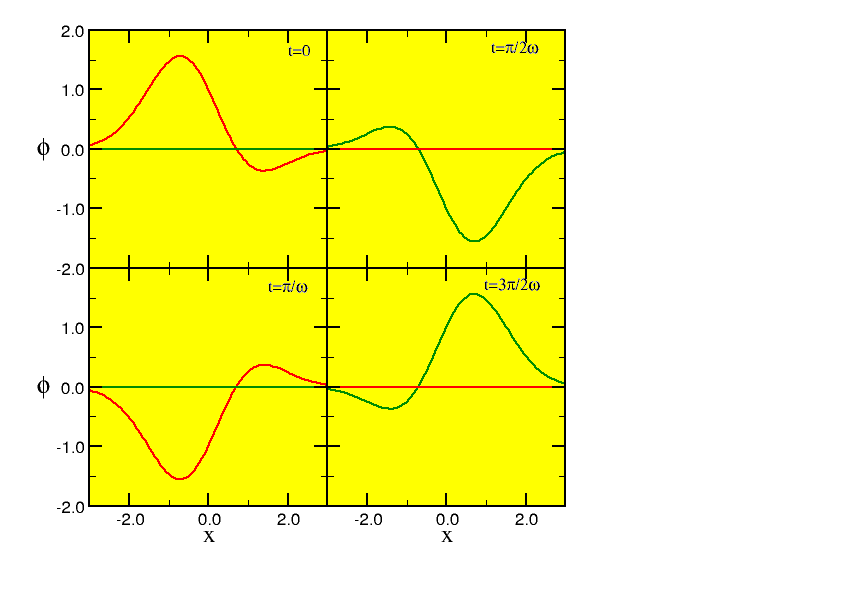Warning: jsMath
requires JavaScript to process the mathematics on this page.
10.4 The best way to clarify this abstract discussion is to consider the quantum mechanics of the Harmonic oscillator of
mass m and
frequency ω ,
\hat{H} = −{{ℏ}^{2}\over
2m} {{d}^{2}\over
d{x}^{2}} + {1\over
2}m{ω}^{2}{x}^{2}.
(10.8)
If we assume that the wave function at time t = 0
is a linear superposition of the first two eigenfunctions,
\begin{eqnarray}
ψ(x,t = 0)& =& \sqrt{{1\over
2}}{ϕ}_{0}(x) −\sqrt{{1\over
2}}{ϕ}_{1}(x), %&
\\
{ϕ}_{0}(x)& =&{ \left ({mω\over
πℏ} \right )}^{1∕4}\mathop{ exp}\nolimits \left (−{mω\over
2ℏ} {x}^{2}\right ), %&
\\
{ϕ}_{1}(x)& =&{ \left ({mω\over
πℏ} \right )}^{1∕4}\mathop{ exp}\nolimits \left (−{mω\over
2ℏ} {x}^{2}\right )\sqrt{
{mω\over
ℏ}} x.%&(10.9) \\
\end{eqnarray}
(The functions {ϕ}_{0}
and {ϕ}_{1}
are the normalised first and second states of the harmonic oscillator, with energies
{E}_{0} = {1\over
2}ℏω and
{E}_{1} = {3\over
2}ℏω .) Thus
we now kow the wave function for all time:
\begin{eqnarray}
ψ(x,t)& =& \sqrt{{1\over
2}}{ϕ}_{0}(x){e}^{−{1\over
2}iωt} −\sqrt{{1\over 2}}{ϕ}_{1}(x){e}^{−{3\over
2}iωt}.%&(10.10) \\
\end{eqnarray}
In figure 10.1 we plot this quantity for a few times.
The best way to visualize what is happening is to look at the probability density,
\begin{eqnarray}
P(x,t)& =& ψ{(x,t)}^{∗}ψ(x,t) %&
\\
& =& {1\over
2}\left ({ϕ}_{0}{(x)}^{2} + {ϕ}_{
1}{(x)}^{2} − 2{ϕ}_{
0}(x){ϕ}_{1}(x)\mathop{cos}\nolimits ωt\right ).%&(10.11) \\
\end{eqnarray}
This clearly oscillates with frequency ω .
Question: Show that {\mathop{\mathop{\mathop{∫
}\nolimits }}\nolimits }_{−∞}^{∞}P(x,t)dx = 1 .
Another way to look at that is to calculate the expectation value of
\hat{x} :
\begin{eqnarray}
\langle \hat{x}\rangle & =& {\mathop{\mathop{\mathop{∫
}\nolimits }}\nolimits }_{−∞}^{∞}P(x,t)dx %&
\\
& =& {1\over
2}{\underbrace{ {\mathop{\mathop{\mathop{∫
}\nolimits }}\nolimits }_{−∞}^{∞}{ϕ}_{
0}{(x)}^{2}xdx}}_{
=0} + {1\over
2}{\underbrace{ {\mathop{\mathop{\mathop{∫
}\nolimits }}\nolimits }_{−∞}^{∞}{ϕ}_{
1}{(x)}^{2}xdx}}_{
=0} −\mathop{ cos}\nolimits ωt{\mathop{\mathop{\mathop{∫
}\nolimits }}\nolimits }_{−∞}^{∞}{ϕ}_{
0}(x){ϕ}_{1}(x)xdx%&
\\
& =& −\mathop{cos}\nolimits ωt\sqrt{ {ℏ\over
mω}} {1\over
\sqrt{π}}{\mathop{\mathop{\mathop{∫
}\nolimits }}\nolimits }_{−∞}^{∞}{y}^{2}{e}^{−{y}^{2}
} %&
\\
& =& −{1\over
2}\sqrt{ {ℏ\over
mω}}\mathop{cos}\nolimits ωt. %&(10.12) \\
\end{eqnarray}
This once again exhibits oscillatory behaviour!

